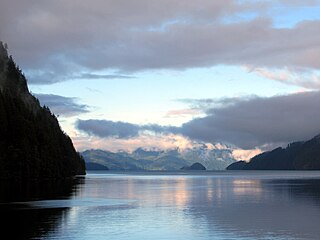
Small hydro is the development of hydroelectric power on a scale suitable for local community and industry, or to contribute to distributed generation in a regional electricity grid. Exact definitions vary, but a "small hydro" project is less than 50 megawatts (MW), and can be further subdivide by scale into "mini" (<1MW), "micro" (<100 kW), "pico" (<10 kW). In contrast many hydroelectric projects are of enormous size, such as the generating plant at the Three Gorges Dam at 22,500 megawatts or the vast multiple projects of the Tennessee Valley Authority.

The W. A. C. Bennett Dam is a large hydroelectric dam on the Peace River in northern British Columbia, Canada. At 186 metres (610 ft) high, it is one of the world's highest earth fill dams. Construction of the dam began in 1961 and culminated in 1968. At the dam, the Finlay, the Parsnip and the Peace rivers feed into Williston Lake, also referred to as Williston Reservoir. It is the third largest artificial lake in North America as well as the largest body of fresh water in British Columbia. Williston Lake runs 250 kilometres north–south and 150 kilometres east–west.
The British Columbia Hydro and Power Authority, operating as BC Hydro, is a Canadian electric utility in the province of British Columbia. It is the main electricity distributor, serving more than 4 million customers in most areas, with the exception of the City of New Westminster, where the city runs its own electrical department and portions of the West Kootenay, Okanagan, the Boundary Country and Similkameen regions, where FortisBC, a subsidiary of Fortis Inc. directly provides electric service to 213,000 customers and supplies municipally owned utilities in the same area. As a provincial Crown corporation, BC Hydro reports to the BC Ministry of Energy, Mines and Low Carbon Innovation, and is regulated by the British Columbia Utilities Commission (BCUC). Its mandate is to generate, purchase, distribute and sell electricity.

Revelstoke Dam, also known as Revelstoke Canyon Dam, is a hydroelectric dam spanning the Columbia River, 5 km (3.1 mi) north of Revelstoke, British Columbia, Canada. The powerhouse was completed in 1984 and has an installed capacity of 2480 MW. Four generating units were installed initially, with one additional unit (#5) having come online in 2011. The reservoir behind the dam is named Lake Revelstoke. The dam is operated by BC Hydro.

Toba Inlet is one of the lesser, but still principal, inlets of the British Columbia Coast. It is fourth in the series north from the 49th parallel which begins with Burrard Inlet, which is the harbour for the city of Vancouver. Between it and Jervis Inlet to its east, however, there is a freshwater fjord, Powell Lake, which has been augmented by a small hydro project to supply power to the large pulp mill at Powell River, the principal town of the Malaspina Peninsula of the upper Sunshine Coast. Klahoose 1 Reserve, of the Klahoose First Nation is at the mouth of Toba River at the Head of Toba Inlet. Toba Inlet and the Toba Valley is home to many grizzly bears.

Run-of-river hydroelectricity (ROR) or run-of-the-river hydroelectricity is a type of hydroelectric generation plant whereby little or no water storage is provided. Run-of-the-river power plants may have no water storage at all or a limited amount of storage, in which case the storage reservoir is referred to as pondage. A plant without pondage is subject to seasonal river flows, so the plant will operate as an intermittent energy source. Conventional hydro uses reservoirs, which regulate water for flood control, dispatchable electrical power, and the provision of fresh water for agriculture.

The ƛoʔos Klahoose are one of the three groups comprising the ʔayʔaǰuθəm Tla'Amin or Mainland Comox. The other two divisions of this once-populous group are the χʷɛmaɬku Homalco and Sliammon. The Klahoose, Homalco and Sliammon are, according to oral tradition, the descendants of the survivors of the Great Flood. The three groups were split by colonialism into different band councils but united historically as the Tla A'min, known as the Mainland Comox, and K’ómoks, the larger grouping of the Comox people, also known as the Island Comox and before the merger with the Laich-kwil-tach culture. Historically both groups are a subgroup of the Coast Salish though the K’ómoks name is from, and their language today, is the Lik'wala dialect of Kwak'wala. The ancestral tongue is the Comox language, though the Sahtloot/Island dialect is extinct.
Rutherford Creek is a tributary of the Green River, British Columbia, Canada, entering that river a few miles above Nairn Falls Provincial Park, near the village of Pemberton. The creek's headwaters are on the eastern side of the Pemberton Icefield, from where it flows southeast for the first half of its course, then generally east for the remainder. It is approximately 24 km (15 mi) in length. The mouth is at 50° 16' 3" N, 122° 57' 41" W.
The Toba River is a river in the Canadian province of British Columbia. Also referred to as the East Toba river. Its drainage basin is 1,759 square kilometres (679 sq mi) in size.
The Waneta Dam is a concrete gravity-type hydroelectric dam on the Pend d'Oreille River in the Canadian province of British Columbia. It lies 9.5 kilometres (6 mi) downstream of Seven Mile Dam at the Pend d'Oreille's confluence with the Columbia River. It is located about 12.5 kilometres (8 mi) southeast of Trail and 0.35 kilometres (0.2 mi) north of the U.S. border at Washington.

The Site C Dam is a hydroelectric dam currently under construction on the Peace River, 14 kilometers southwest of Fort St. John in northeastern British Columbia, Canada. It is located approximately 80 kilometers downstream from the W. A. C. Bennett Dam. When completed in 2025, the Site C Dam will become the 4th largest producer of hydroelectricity in British Columbia with an expected capacity of 1,100 MW and an expected annual output of 4,600 GWh of electricity.
GE Energy Financial Services (EFS), a division of GE Vernova headquartered in Stamford, Connecticut, United States, provides financial and technological investment in energy infrastructure projects around the world. EFS is active within industries such as power generation and distribution, oil and gas, pipelines and storage, water, venture capital, and renewable energy. EFS portfolios include deepwater oil and gas exploration in Brazil and water pipeline projects in Jordan.
The Dokie Ridge Wind Farm is a wind farm located near Chetwynd, British Columbia, Canada. It was put into commercial operation in 2011. The facility has a generating capacity of 144 megawatts and it produces 320 to 340 gigawatt-hours of energy per year. . Electrical engineering consulting services are provided by Lex Engineering Ltd. BC Hydro announced the project was in commercial operation as of February 16, 2011. The project was built in partnership between GE and Plutonic Power Corporation. The wind farm has 48 Vestas V90 3 MW turbines, an electrical substation and seven kilometers of transmission line. The project cost about $228 million (Canadian).
Veresen Inc. was a Calgary, Alberta-based energy infrastructure company with three main lines of business: pipelines, natural gas and power generation. It was a publicly-traded company on the Toronto Stock Exchange, and was known as Fort Chicago Energy Partners L.P. In 2017, it was acquired by Pembina Pipeline for $9.7 billion.

Alterra Power Corp. a subsidiary of Innergex Renewable Energy Inc., is a diversified renewable power generation company based in Vancouver, British Columbia, Canada. It was formed in 2011 through the merger of Magma Energy Corp. and Plutonic Power Corp. It develops, owns, acquires and operates hydroelectric, wind, solar energy and geothermal projects. On February 6, 2018, Innergex Renewable Energy Inc. completed the acquisition of Alterra including all its assets.
Innergex Renewable Energy is a developer, owner and operator of run-of-river hydroelectric facilities, wind energy, and solar farms in North America, France and South America. While many of the firm's operational assets are located in its home province of Québec, it has expanded into Ontario, British Columbia, and Idaho, as well as Chile and France
Cloudworks Energy Inc. was a private, Vancouver-based run-of-river hydro developer formed in 1999. The firm's principals developed the 33MW Miller Creek run-of-river project and the 49.9MW Rutherford Creek project. In 2011 Innergex Renewable Energy acquired Cloudworks Energy Inc.
The Tahumming River is a river in the Pacific Ranges of the Coast Mountains in British Columbia, Canada, flowing southeast into Toba Inlet near that inlet's head.
Independent power producer (IPP) projects have had a significant presence in British Columbia since the 1980s. Their relationship with BC Hydro grew from the province's need to supply growing energy demands and implementation of the 2002 Energy Strategy, which mandated that BC Hydro would purchase its energy supply from IPPs rather than generating the supply itself. There are a variety of power projects in BC, with the most popular being hydroelectricity and biomass projects. In recent years, more attention has been placed on the environmental effects of IPP projects and the social implications it has to residents living around the project development sites. Despite the decline in demand for new IPP projects, in 2016 they supplied 20,000 GWh, one-third of BC Hydro's total.







